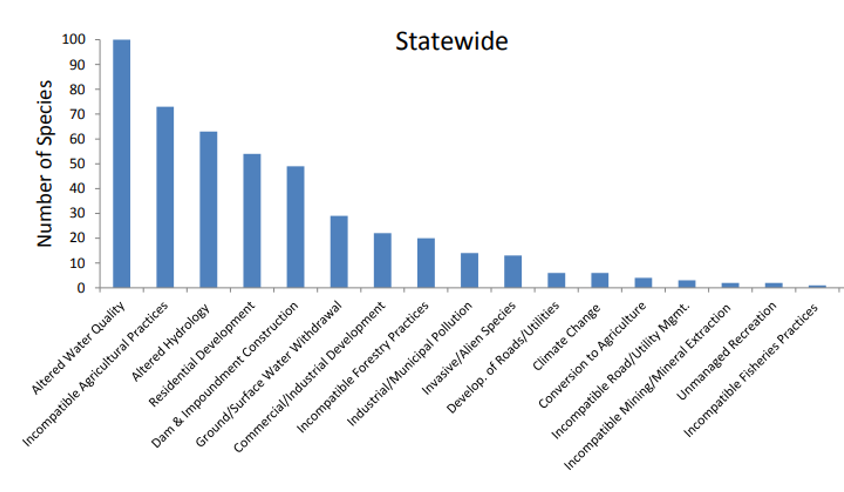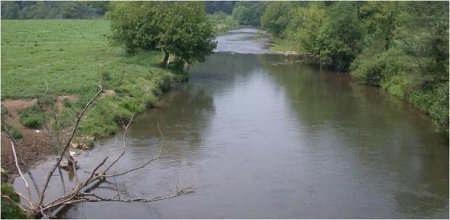- General Threats and Conservation Actions for Aquatic Species and Habitats
- Aquatic Conservation Partnerships
- References
The southeastern United States is a well-recognized hotspot for global aquatic biological diversity (Abell et al. 2000; Collen et al. 2014; Elkins et al. 2016) and is among the richest areas in the temperate world for freshwater crayfishes, fishes, mussels, snails and other aquatic groups (Jelks et al. 2008; Johnson et al. 2013; Taylor et al. 2007; Williams et al. 1993). Georgia exemplifies this pattern and ranks among the top five U.S. States in the number of native species of mussels (127), fishes (265), crayfishes (70) and aquatic snails (84).
Unfortunately, Georgia also ranks among the top states in imperiled freshwater aquatic species. Georgia’s State Wildlife Action Plan (Appendix E) recognized 152 imperiled freshwater aquatic species in Georgia, more than half of which have a significant portion of their global range within the state’s boundaries. Approximately 22 percent of Georgia’s freshwater fishes, 28 percent of mollusks and 36 percent of crayfishes are ranked as imperiled or critically imperiled in the state. Yet even these numbers understate the problem because they don’t include an additional 48 species, most of them mollusks, considered historic or extirpated from Georgia.
There are important populations of rare aquatic species distributed throughout the state of Georgia. However, certain part of the state, such as the Coosa drainage in northwest Georgia, support an exceptional diversity of both common and rare species. As part of Georgia’s Wildlife Action Plan (Appendix F), experts prioritized all of Georgia’s watersheds based upon the number of rare aquatic species present as well as the global conservation importance of each species.

You can find more information about Georgia’s rare aquatic species on the Georgia Biodiversity Portal, including range maps, species profiles, and photographs. You can also create a custom list of Georgia’s aquatic species that are listed under the U.S. Endangered Species Act or the Georgia Endangered Wildlife Act, or designated as a conservation priority under Georgia’s State Wildlife Action Plan by visiting our Rare Aquatic Species List. You can also search your local watershed and other geographic areas by visiting Rare Aquatic Species by Location.
General Threats and Conservation Actions for Aquatic Species and Habitats
Georgia’s aquatic species are threatened by a myriad of factors, including urbanization, poor land use practices associated with historic and current agricultural and forestry operations, reservoirs and altered hydrology, chemical pollution, invasive species, and climate change. Below we explain each of these factors and provide recommendations on how to minimize their impact on aquatic resources. The purpose of this discussion is not to impugn any one land use type or economic sector but to show that we are all connected to aquatic habitat degradation and that we can all help to correct and prevent these problems. Georgia’s State Wildlife Action Plan (Appendix E) summarized threats impacting Georgia’s high priority aquatic species. Threats to individual species are described within species profiles on the Georgia Biodiversity Portal.
Other resources include:
- Stream Crossings in Georgia: a Handbook for Connectivity and Resilience
- Georgia Dam Removal Handbook

Urbanization

Urbanization negatively affects stream ecosystems in a multitude of ways. Impervious surfaces (e.g., rooftops, parking lots, roads) accelerate runoff after rainfall events, leading to erosive flooding and degradation of instream habitats. This runoff also carries many pollutants into streams. Because water rapidly runs off, instead of infiltrating into the groundwater more slowly, there is less water available in streams during low-flow periods. The effect of urbanization on aquatic communities has been well documented by scientists, who have discovered that some fish species are becoming extirpated (i.e., locally extinct) at very low-levels of impervious cover (< 5% of watershed area). Everyday citizens can help by minimizing or avoiding the use of fertilizers and pesticides in their yards, maintaining vegetated buffers along streams, and by constructing a rain garden to promote infiltration of runoff on their property.
Agriculture & Forestry
Agricultural activities also threaten aquatic species populations, primarily through run-off of sediment, nutrients, and pesticides. These impacts are most extreme in areas where cultivation occurs right up to stream banks or when livestock are allowed access to streams for watering. Sedimentation, which can also result from forestry practices and construction activities, is a widespread problem in Georgia streams. Suspended sediment decreases water clarity and interferes with sight-feeding and other visually oriented fish and mussel behaviors (e.g., territorial displays, lures used by mussels to attract their fish hosts). Sediment also fills in the spaces between larger rocks, which eliminates habitats used for spawning, feeding, and shelter. Nutrient pollution from such sources as fertilizer runoff and animal waste can lead to algal blooms, which in turn may affect water clarity, oxygen levels, and also the condition of other aquatic plants that are beneficial to aquatic species (e.g., Riverweed). Farmers can help protect streams by maintaining wide forested buffers along creeks and streams. There are also many technical assistance and cost-sharing programs that can help farmers implement best management practices, such as restricting cattle access to streams.
This video shows the sediment runoff into a small creek in south Georgia during a 10 minute storm in August 2007. Notice the clear water from the naturally forested watershed upstream of the drainage ditch in contrast to the brown color of water washing into the creek from the ditch.

Depending upon the size of the operation and its location, forestry operations may negatively impact streams and their aquatic species. Mechanisms of impact include sediment runoff associated with vegetation removal, soil disturbance from forestry equipment, and stream bank destabilization from poorly designed stream crossings. Additionally, the removal of trees from sensitive habitats such as cypress swamps, floodplains, or other wetlands contributes to sedimentation and increases in water temperature. The Georgia Forestry Commission has developed best management practices to minimize the impacts of forestry on streams.
Reservoirs and Altered Hydrology
Because most of our native riverine aquatic species cannot survive or complete their life-cycles in deep or slow-flowing habitats, large amounts of habitat are destroyed when reservoirs are created. Reservoirs and smaller impoundments (e.g., farm ponds) also fragment stream ecosystems and prevent the movement of animals between upstream and downstream habitats. Such movements are necessary for spawning migrations and feeding, and for colonization when disturbances (e.g., drought, chemical spill, etc.) eliminate upstream populations. Depending upon their size and outflow structure, reservoirs may also alter natural streamflow patterns and water quality downstream of the reservoir.
One of the best ways to minimize the impacts of reservoirs on native aquatic species is to adopt water conservation practices that prevent the need for additional reservoirs. American Rivers released a report in 2008 showing how water efficiency measures decrease the need for additional reservoirs and also conserve significant taxpayer dollars. If water demand cannot be met entirely through efficiency measures or existing water withdrawals, then there are ways to minimize the impacts of new reservoirs.
For example, expanding the size of an existing reservoir is usually much less detrimental than building a new reservoir. Similarly, locating a reservoir in a stream with existing downstream reservoirs will fragment fish populations less than building new reservoirs in free-flowing systems. Some new reservoirs are off-channel, meaning that they are built on smaller tributary streams but are filled by pumping water from a larger river. Although it may be more costly to filter water during floods, filling these reservoirs during high flow events is much less harmful than removing water during normal or low-flow periods.

Our program reviews proposals for new reservoirs and can help applicants identify areas that would be least detrimental to state and federally listed fishes. Early coordination with us and other resource agencies will usually result in a better process and outcome for the applicant and for natural resources. The Georgia Aquatic Connectivity Team is working to remove obsolete dams and other barriers to the natural movements of aquatic species in Georgia.
Chemical Pollution
The effect of pesticides and other chemicals originating from industrial sources may cause lethal effects in rare cases but more frequently are associated with subtle effects which may ultimately have similar consequences. Chemicals may reduce immune system function making aquatic species more susceptible to diseases. Pesticides often affect the nervous system and cause altered behavior which can make an aquatic species less effective at feeding or hiding from predators. A number of chemicals have been shown to interfere with the endocrine system of fish, which regulates reproduction, growth, development and other activities. 'Intersex' fish, usually male fish with oocytes in their gonads, have been found in rivers across the country, including Georgia, often near treated sewage effluents. These 'feminized' males can have reduced ability to reproduce successfully.
Invasive Species
Non-native organisms may negatively affect Georgia’s aquatic species. Potential impacts include direct predation, competition for habitat and food, and disease. These factors are a natural part of aquatic ecosystems and our species have adapted to them throughout their shared evolutionary history with other native species. However, native aquatic species may be poorly adapted to these factors when they are associated with introduced species. For example, native bullhead catfishes (Ameiurus spp) maintain healthy populations in the face of flathead catfish predation where both species naturally occur, but suffer large population declines where flathead catfish have been introduced. Another important impact of non-native species is the loss of unique genetic diversity when closely related species interbreed. For example, the red shiner (Cyprinella lutrensis) readily hybridizes with other shiners in the genus Cyprinella where it has been introduced outside of its native range.
Once a non-native species has become established, it is very difficult or perhaps impossible to eradicate them. Thus, strategies to prevent the accidental introduction of non-native species are critical to the protection of our native species. Anglers, recreational boaters, and aquarists have a very important role to play in preventing additional introductions and the further spread of species that have already been introduced. Please visit our aquatic nuisance species page to learn more about what you can do.
Climate Change
Through projected changes in stream temperatures, increased intensity of floods and droughts, and the impacts of sea-level rise on freshwater habitats near the coast, the impact of climate change on Georgia’s aquatic species and habitats is likely to be substantial. Species with limited dispersal ability and/or having limited tolerance to changes in temperature and other water quality parameters are most at risk. For example, freshwater mussel populations may become extirpated from streams where water withdrawals and extended droughts result in cessation of stream flow for extended periods. Similarly, cold water species adapted to Blue Ridge mountain streams and rivers are expected to decline with projected increases in water temperature.
Many standard aquatic habitat conservation practices can help lessen the impact of climate change on aquatic species. Protection and re-forestation of riparian zones can help mitigate increases in stream temperature. Improved technology and other water conservation efforts can decrease the amount of water removed from streams during droughts. By allowing species to move to refuge habitats or colonize habitats after local extinction, the protection of free-flowing streams and the removal of barriers to aquatic organism passage will make Georgia’s species and habitats more resilient to climate change impacts.
Aquatic Conservation Partnerships
The Wildlife Conservation Section has primary responsibility to meet the conservation, research and monitoring needs for Georgia’s aquatic species, with the exception of sport fishes that are managed by our Fisheries Management Section. Our work is guided by the Georgia State Wildlife Action Plan, which identified high priority aquatic species, high priority watersheds and specific conservation actions for both. We maintain a large database of species distribution records, which is used in a variety of ways to protect species and aquatic habitats. We are constantly updating the database with new information from surveys and monitoring efforts carried out by our staff or by our conservation partners.
Protecting aquatic species populations requires watershed-level conservation efforts, which is well beyond the capacity of our program. Protecting Georgia’s fishes, mussels, and crayfishes depends upon the cooperation and effort of local governments, conservation groups, state and federal agencies, and everyday citizens just like you. Some of the groups we routinely work with include:
- Altamaha Mollusk Candidate Conservation Agreement
- Conservation Fisheries
- The Georgia Aquarium
- The Georgia Aquatic Connectivity Team
- Georgia Cooperative Fish and Wildlife Research Unit
- The Georgia River Network
- The Georgia DNR Stream Survey Team
- The Georgia Museum of Natural History
- The Nature Conservancy
- The River Basin Center
- The Robust Redhorse Conservation Committee
- The Sicklefin Redhorse Working Group
- The Tennessee Aquarium Conservation Institute
- The Joseph W. Jones Ecological Research Center
- United States Fish and Wildlife Service-Ecological Services Office
- United States Forest Service
References
- Abell, R., D.M. Olson, E. Dinerstein, P. Hurley, J.T. Diggs, W. Eichbaum, S. Walters, W. Wettengel, T. Allnutt, C. Loucks, and P. Hedao. 2000. Freshwater ecoregions of North America: a conservation assessment. Island Press, Washington, DC.
- Collen, B., F. Whitton, E. Dyer, J. Baillie, N. Cumberlidge, W. Darwall, C. Pollock, N. Richman, A. Soulsby, and M. Bohm. 2014. Global patterns of freshwater species diversity, threat and endemism. Global Ecology and Biogeography 23: 40–51.
- Elkins, D.C., S.C, Sweat, K.S. Hill, B.R. Kuhajda, A.L. George, and S.J. Wenger. 2016. The southeastern aquatic biodiversity strategy. University of Georgia River Basin Center. 237 pp. Available online.
- Johnson, P. D., A. E. Bogan, K. M. Brown, N. M. Burkhead, J. R. Cordeiro, J. T. Garner, P. D. Hartfield, D. A. W. Lepitzki, G. L. Mackie, E. Pip, T. A. Tarpley, J. S. Tiemann, N. V. Whelan, and E. E. Strong. 2013. Conservation Status of Freshwater Gastropods of Canada and the United States. Fisheries 38(6):247-282.
- Taylor, C.A., G.A. Schuster, J.E. Cooper, R.J. DiStefano, A.G. Eversole, P. Hamr, H.H. Hobbs, III., H.W. Robison, C.E. Skelton, and R.F. Thoma. 2007. A reassessment of the conservation status of crayfishes of the United States and Canada after 10+ years of increased awareness. Fisheries 32(8): 372–389.
- Williams, J. D., M. L. Warren, Jr., K. S. Cummings, J. L. Harris, and R. J. Neves. 1993. Conservation status of the freshwater mussels of the United States and Canada. Fisheries 18:6–22.